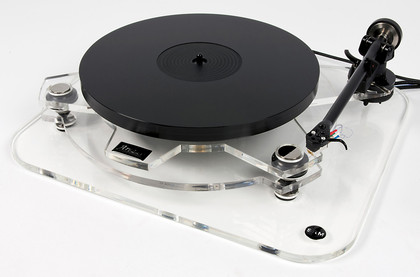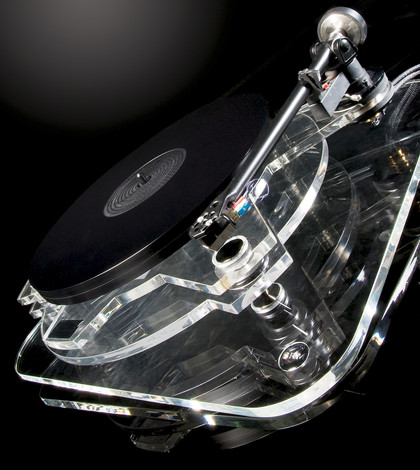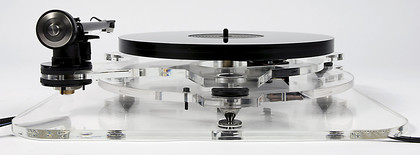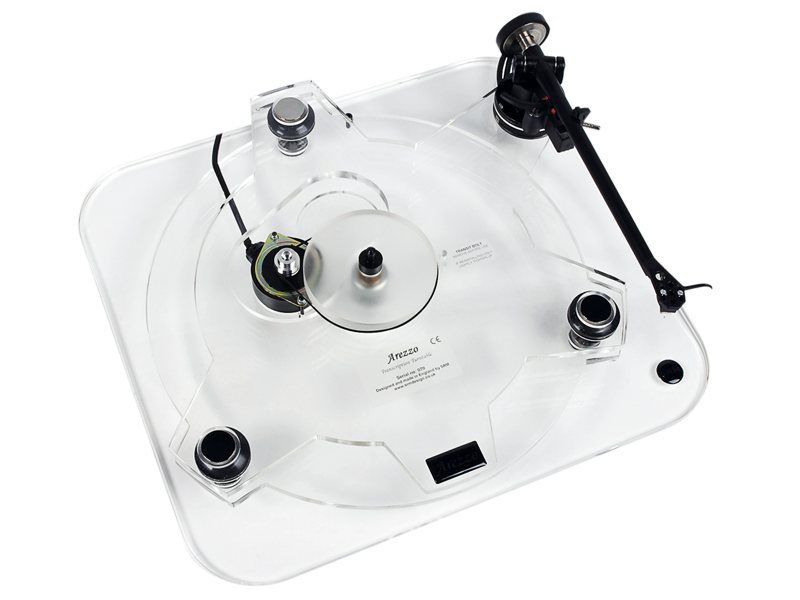TechRadar Verdict
The Arezzo is an excellent source component for those wanting a superb turntable for vinyl replay. Whether you're new to vinyl, or an established vinyl fan with a big collection, the Arezzo will bring your LPs to life
Pros
- +
Basic Arezzo produces superb results at a realistic price
- +
Offers a clear upgrade path
Cons
- -
Fiddly speed change
- -
Expensive optional lid
Why you can trust TechRadar
The key aspect of the SRM Arezzo turntable is that it's a good-sounding product that's keenly priced and readily upgradeable. True audiophiles are always keen on upgrades. If nothing else, it lets you start with the basic model and then make improvements as funds permit.
There are three versions based on a common chassis: the basic Arezzo (£699); the Arezzo Kinetic (£1,148); and the Arezzo Ultra (£1,698) – plus an Arezzo Reference at £2,998.
The Arezzo features a resonance-controlled two-part acrylic plinth with three-point isolation. An AC synchronous motor drives the platter via a sub-platter using a 'Duo Drive' twin-belt system.
Speeds of 33rpm and 45rpm are offered and changing speeds entails the platter being removed and the belts shifted over to different pulleys. Because of the extra belts, this is slightly fiddly – not ideal for those who want to change speeds often.
It's usually impossible to say that any one part of a turntable is more important than another, but there's no question that the motor and drive system play a crucial role in determining the final quality of sound.
SRM believes in a 'tight' coupling between motor and platter to avoid loss of detail and dynamics and ensure good speed stability. An LP record is an analogue device, so the 'load' on the motor varies according to the loudness of the music being played – the louder it gets, the greater the 'drag' on the drive system.

While decoupling the motor from the platter may lower noise levels and improve isolation, the lack of a good, solid drive leads to a loss of focus and slight pitch waver – particularly noticeable with instruments like piano that produce sounds with sharp, fast-transients.
In the Arezzo, the motor is situated very close to the inner platter and couples to it via two short square-section drive belts. The Kinetic upgrade adds a second 'flywheel' pulley and employs five drive belts to give increased traction.
Naturally, the facility to upgrade the deck is welcome, but the important question is – what standard of performance is offered by the basic model? – is it good enough to satisfy without the add-ons? We've lived with the 'full Monty' Arezzo Ultra for some months now and been very satisfied with the results.
But, while the Ultra offers a worthwhile improvement over the cheaper versions, the basic Arezzo is very good. Arezzo designer Stuart Michell recently made a simple improvement to the deck that (he feels) makes the basic Arezzo sound superior to the Arezzo Kinetic. The mod derived from work done on the Arezzo Reference, it's simple to fit and is available as a free upgrade kit.
The upgrade consists of seven 4mm round platter-support points made from rubber. This improves the isolation between platter and main bearing/motor, as well as damping the main bearing slightly.
Sound quality
To ensure a fair comparison, we used the same arm and cartridge we'd been using on the Arezzo Ultra. First impressions certainly seem to bear out Stuart's claims. The standard Arezzo produce a bright, open, tonal balance with excellent control and coherence, sounding crisp and focused, with excellent fine detail and dynamics.
Although the more expensive turntable remains superior in certain aspects, the basic model gives it a very good contest. The sound is detailed and clean, displaying the open 'airy' qualities we associate with the Arezzo Ultra – not especially rich or warm, but very crisp and tactile. Definitely no fake-tan 'analogue warmth' here!
The bass sounds full, but not overly powerful. The low end has a tidy clean quality that sounds tight and controlled, if not especially deep or voluminous. However, a better arm (we used the Moth Mk 1 with incognito wiring) would no doubt change this.
We've been really impressed by how secure and stable the Arezzo Ultra sounds. Not just in terms of solid image placement, but pitch. There's a complete lack of pitch waver – something you rarely encounter with LP. It was almost like listening to CD – and we mean that as a compliment.
Although the basic Arezzo lacks the flywheel and big power supply, it also offers the excellent pitch stability of its bigger brothers. If there is a loss of security, it's very slight. We half expected the basic Arezzo to be noticeably less stable than the Kinetic or Ultra models, but, it's not.

Difficult piano LPs reproduce with pitch stability that invites comparison with big expensive turntables – those having ridiculously heavy platters, huge motors and frightening price tags.
However, the Arezzo avoids the Brute Strength and Ignorance approach, taking a different path. It has a (comparatively) light acrylic platter and a normal-sized motor – albeit a higher torque version than other manufacturers' use. Yet it achieves outstanding speed stability. How?
The secret seems to be its multi-belt drive. Designer Stuart Michell believes the motor (rather than a heavy platter) is boss – and, therefore, it needs to drive the platter without loss of torque. Thus, there is very little decoupling between motor and platter; the square section belts are deliberately kept short and tight to minimise springiness.
The Arezzo certainly allows the listener to relax – something not always possible with vinyl. One huge benefit with CD is its sheer reliability; it rarely ever breaks up or gets stuck, and has no background noise or speed (pitch) irregularity problems. CD has its own irksome faults, but not these.

Being an analogue turntable, the Arezzo is prone to the faults of vinyl LPs. But subjectively, it almost sounds as though it isn't. It gives a remarkably solid and assured performance that rarely feels as if it's about to go off the rails.
Even demanding LPs reproduce with surprising calm. The pickup sounds as if it is having a (relatively) easy time of things and gives the impression of being able to cope with whatever the grooves might throw at it. Even when a disc did have a bit of turbulence, it was usually handled with relaxed ease.
In the past, we've heard turntables that offered similar qualities, but nearly always they've been big, heavy, extremely expensive monsters with massive platters and humongous motors. That the Arezzo does what it does with (comparatively) modest resources is impressive and largely down to the drive system used.
Stuart Michell uses a special high-torque version of the Premotec AC motor. This motor – a derivative of the old Phillips motor used in the Linn and Rega – has increased 'drive'. Indeed, Stuart claims the standard Premotec motor would not have the necessary torque to drive the Kinetic flywheel.
With multi-belt drive, the motor is most definitely in charge of the platter. Some turntables simply use the motor to get the platter up to speed; once achieved, stability is maintained by the flywheel effect of the (heavy) platter. With the Arezzo, the motor is the driving force.
While you do get further improvements in sound quality with the Kinetic and Ultra upgrades – essentially, a subtler more finely shaded sound with greater detail and dynamics – the standard Arezzo performs superbly, giving most listeners everything they will ever need from a vinyl replay source. We can't recommend it highly enough.
Follow TechRadar Reviews on Twitter: http://twitter.com/techradarreview
